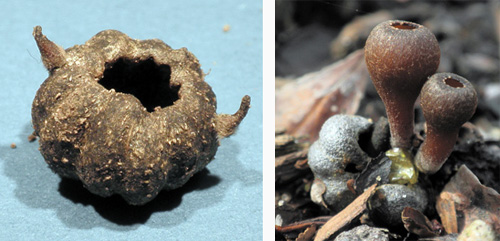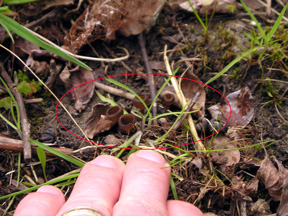Mummy berry poised for action in blueberries
Mummy berry is caused by the fungus Monilinia vaccinii-corymbosi and is characterized by blighting of young shoots, which are referred to as “shoot strikes”.
Editor’s note: This article is from the archives of the MSU Crop Advisory Team Alerts. Check the label of any pesticide referenced to ensure your use is included.
Mummy berry is caused by the fungus Monilinia vaccinii-corymbosi and is characterized by blighting of young shoots, which are referred to as “shoot strikes”. Fruit infection leads to the shriveling and mummification of berries, hence the name mummy berry. Most mummified berries fall to the ground before harvest, but some make it into the harvested lugs. There is also a zero tolerance for mummified berries in processed fruit. Mummified berries actually consist of a compact mass of the fungus covered with the remnants of the fruit skin. They overwinter on the ground below blueberry bushes, and need sufficient moisture and chilling hours to prepare them for the next growing season.
At the beginning of growing the season, small trumpet-shaped apothecia develop on the overwintered mummies and start to release ascospores which infect young leaves. Previous research has shown that the optimum temperature for formation of apothecia is 50 to 57ºF (10 to 14ºC). These temperatures are also very conducive to leaf infection, which requires at least 6 hours of continuous leaf wetness under those conditions. Infection can occur at temperatures as low as 36ºF, but a wetness period of 10 hours is required for infection at that temperature. In general, longer wetness periods lead to more severe infection. Growers should scout for mummy berry and consider fungicide treatment if leaf tissue is available and mummies with apothecia are found.
On April 5, 2010, mummies were found in all four scouted blueberry fields and had apothecia at early stages of development (Table 1). The mummies appeared about two weeks ahead in their development compared to last year, most likely due to higher temperatures. The number of mummies on the ground and percent germination varied between sites but was as high as 15% in the West Olive site. Overall, infection risk in early April was deemed fairly low because most apothecia were less than 1-2 mm in diameter and 2 mm is the minimum size for release of ascospores. Also, the number of ascospores released is low when apothecia are still small, but increases with increasing apothecial diameter.
On April 12, 2010, significantly more mummies with apothecia were detected and germination rates were over 30% at two of the sites. In addition, apothecial diameter was larger (up to ½ inch) than the week before. This suggests that infection risk will be high this week and next. If extended leaf wetness occurs (at least 6 hours at 57-65 F), this presents a severe infection risk. Frost injury can exacerbate the risk of infection.
If mummies are present in your blueberry field, apothecia are at least 2 mm in diameter, and green leaf tissue is present, a fungicide application is recommended to prevent shoot strike infections. Indar (fenbuconazole) and Orbit (propiconazole) are effective systemic fungicides that can be applied protectively or within 24 hours of an infection period. Protectant fungicides are rated as follows for protection against shoot strikes: Serenade + Nu-Film-P adjuvant (good), Sulforix (good), Ziram (fair), Bravo (fair), Omega (fair), CaptEvate (fair), Captan (poor). Strobilurins (e.g., Abound, Cabrio, Pristine) may be rated as fair, are not recommended for use early in the season to control mummy berry shoot strikes. They are more cost-effective when used against mummy berry and other fungal infections during bloom.
Table 1. Mummy berry scouting information from blueberry fields in Michigan, 2010.
| Van Buren County | |||||
| Farm | Date | Number of mummies on the ground per bush* | % Germinated mummies | Number of apothecia on the ground per bush* | Maximum apothecium size in inches (mm) |
| Covert | 4-5 | 0.7 | 0.0% | 0.0 | 0 in (0 mm) |
| 4-12 | 0.9 | 33.3% | 0.7 | "*"*"1/8 in (3 mm) | |
| 4-12 | 112.4 | 31.7% | 54.5 | "*"*"*"*"5/32 in (4 mm) | |
| West Olive | 4-5 | 35.9 | 15.0% | 8.1 | "1/2 in (12 mm) |
*Average of 10 bushes.
|
|||||



 Print
Print Email
Email






